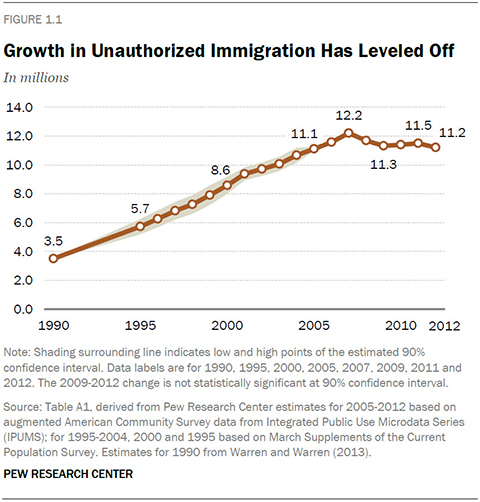With the immigration debate taking center stage in Washington, a Pew Research Center report released Tuesday shows the unauthorized immigrant population has leveled off in the U.S., even as population trends in select states remain more volatile.
From 2009 to 2012, Pew estimates the unauthorized immigrant population rose in seven states and fell in 14. Those 21 states were the ones that had statistically significant changes in their populations of unauthorized immigrants during the period.

Five East Coast states—Florida, Maryland, New Jersey, Pennsylvania and Virginia—were among those where the numbers of unauthorized immigrants grew from 2009 to 2012. Totals also rose in Idaho and Nebraska, according to the center’s estimates.
“In the eastern states were the numbers went up it was due to non-Mexicans almost entirely,” said Jeffrey Passel, a senior demographer at Pew and one of the report’s authors. “The destinations where immigrants chose to go are where they can find jobs and where they have families and friends.”
Passel said the growth in those states is mostly the result of immigrants from Central America, Asia, Europe and the Caribbean.
Six Western states—Arizona, California, Colorado, Nevada, New Mexico and Oregon—were among those with declines in unauthorized immigrant populations from 2009 to 2012. Other states with decreases over that period are in the South (Alabama, Georgia and Kentucky), the Midwest (Illinois, Indiana and Kansas) and the Northeast (Massachusetts and New York).
As early as this week, President Barack Obama is expected to ease immigration policies unilaterally without Congress by signing an executive order that will, among other things, allow up to 5 million undocumented immigrants to avoid deportation.
Republican, who will control both houses of Congress next year, have cautioned that any executive action would damage the prospects of a bipartisan immigration bill and inflame relations between the White House and Capitol Hill.
Nationally, the population of 11.2 million unauthorized immigrants in 2012 was unchanged from 2009, the year the Great Recession ended, according to Pew. The number peaked in 2007 at 12.2 million and declined for the next two years during the recession. This decline contrasts with the period from 1990 to 2007, when the unauthorized immigrant population increased from 3.5 million to 12.2 million, growth of about 250% or an average of more than 500,000 people a year, Pew said.
The declines of unauthorized immigrants in 13 of the 14 states were due to drops in the number of those from Mexico, the report says. The exception was Massachusetts, where the overall decrease was due to a decline in the number of unauthorized immigrants from other countries.

In six of the seven states where populations of unauthorized immigrants grew from 2009 to 2012, it was because the number of non-Mexicans increased. The exception was Nebraska, which had a small but statistically significant increase in Mexican unauthorized immigrants in those years.
“One of the under-appreciated trends in unauthorized immigration is the recent decline,” Passel said. “The numbers fell dramatically at the national level after 2007 for a couple years and since then they have hardly changed at all.”
Passel said much of that decrease was due to “a huge decrease in the number of Mexican immigrants in the country and the number coming to the country.”
There is wide variety in state populations of unauthorized immigrants, according to the Pew Research estimates. More than half the 2012 unauthorized immigrant population (60 percent) lived in the six states with the largest numbers of such immigrants: California, Florida, Illinois, New Jersey, New York and Texas. At the opposite end, six states—Maine, Montana, North Dakota, South Dakota, Vermont and West Virginia—had fewer than 5,000 unauthorized immigrants each in 2012.
Mexicans are a majority of unauthorized immigrants (52 percent in 2012) in the U.S., according to Pew. But both their numbers and share have declined in recent years, from 6.4 million in 2009 to 5.9 million in 2012. The decline likely resulted from both an increase in departures to Mexico and a decrease in arrivals from Mexico, Pew said.
Unauthorized immigrant populations can grow at the state level for the same reasons they do nationally, when immigrants cross the U.S. border without authorization, or when they overstay a legal visa after it expired, Pew said. Some states also may have experienced growth in their populations because unauthorized immigrants moved there from other states.
A major factor contributing to losses in California, Illinois and New York from 2009 to 2012 was movement of unauthorized immigrants to other states, Pew said. Unauthorized immigrant populations can decline when fewer new immigrants arrive, when a greater number decide to leave the country, or through deaths. Numbers can also decline through deportations or when unauthorized immigrants obtain legal status.
Among those believed to be under consideration by Obama for relief from deportation are long-time U.S. residents with U.S.-born children. Pew estimates that 4 million unauthorized immigrant parents, or 38 percent of adults in this population, lived with their U.S.-born children, either minors or adults, in 2012. Of these, 3 million had lived in the U.S. for 10 years or more, according to a Pew report released in September.
Unauthorized immigrants accounted for 3.5 percent of the 2012 U.S. population of nearly 316 million and 26 percent of the nation’s 42.5 million foreign-born residents, Pew estimates. Both shares were larger in 2007, the peak year for the nation’s unauthorized immigrant population, at 4 percent and 30 percent.
Pew generated its unauthorized immigrant estimates using Census Bureau data to compare estimates of the number of immigrants residing legally with the total number of immigrants as measured by a survey, either the American Community Survey or the March Supplement to the Current Population Survey. The difference is assumed to be the number of unauthorized immigrants.
Source Article from http://www.bloomberg.com/politics/articles/2014-11-18/5-east-coast-states-seeing-more-unauthorized-immigrants-report-says
Monday-Thursday, 5 PM ET
http://www.bloomberg.com/politics/articles/2014-11-18/5-east-coast-states-seeing-more-unauthorized-immigrants-report-says
http://news.search.yahoo.com/news/rss?p=immigrant
immigrant – Yahoo News Search Results
immigrant – Yahoo News Search Results
